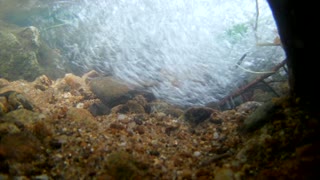Female Diver Video graphing Unknown Electric Fishes Underwater
The Devils Hole pupfish (Cyprinodon diabolis) is the rarest fish in the world. Found only in a single, tiny limestone cavern in the Devils Hole geothermal pool about 100 km east of Nevada’s Death Valley National Park, these fish have the smallest known geographic range of any vertebrate in the wild.
The Devils Hole pupfish (Cyprinodon diabolis) is the rarest fish in the world. Found only in a single, tiny limestone cavern in the Devils Hole geothermal pool about 100 km east of Nevada's Death Valley National Park, these fish have the smallest known geographic range of any vertebrate in the wild.
It’s thought that they made it to this 500,000-year-old limestone cavern when its roof caved in, exposing it and its water to the ground surface. Once inside, the fish got used to the oxygen-poor and super-warm, 33 degree Celsius (93 degrees Fahrenheit) water.
But then a decline in food resources, defects caused by reduced genetic variation and climate change bringing the water temperature up and the dissolved oxygen levels down, the population has been struggling.
Since researchers started monitoring them in the early 1970s, sending scuba divers down into the 129-metre-deep cavern to manually count each individual, the population has decreased from 200 to just 68 to 35 fish in 2013. While more recent population counts have put the number slightly higher than this, they are still at severe danger of extinction, and conservationists have pretty much resigned themselves to the fact that if another population of Devils Hole pupfish is not successfully established elsewhere, they will almost likely disappear altogether.
But of course, relocating a number of these adorable little fish - which rarely grow to more than 2.5 cm long - is easier said than done, and if the process is not carried out properly, it could see the relocated population die off, as well as the original population, having been irreparably depleted. Which is why Steven Beissinger, a UC Berkeley professor of environmental science, policy and management, set out to find the best and safest way to take fish from the Devils Hole pupfish population by performing the first model-based risk analysis for this very special species.
"Some species are critical to conserve because they serve important functions in their ecosystems, and others are important because they might be sources of new medicines, or they may have unique biological features that could inspire human innovation," Beissinger said in a UC Berkeley press release. "We don't know if the Devils Hole pupfish has or ever will serve any of these important functions, which seems unlikely as long as the species remains restricted to its single cavernous refuge. We do know that the pupfish, like all species, has a fundamental right to exist that is independent of its value to humans."
By modelling a range of different scenarios, including removing different numbers of adults, juveniles, and eggs from the Devils Hole cavern, at different times of the year over several years, Beissinger came up with the least risky move - no more than six adults were taken from the Devils Hole cavern population during the course of a year, and only during the autumn months.
-
 0:07
0:07
nscom
3 years agoUnderwater mountain | Short Video
36 -
 1:30:00
1:30:00
vivafrei
3 hours ago4th of July Fishing with Viva! Baldwin Trial UPCOMING! Trump Causing MELTDOWNS! And MORE!
29.4K30 -
 13:32
13:32
TENET Media
3 hours agoThe Left DEFEATED in France | Lauren Southern
7.96K36 -
 23:14
23:14
DepressedGinger
7 hours ago*SHOCKER* Hunter & Joe tell Dems to F*** Off, want to stay in race
10.3K18 -
 2:30:23
2:30:23
Kim Iversen
6 hours agoDocumentary Showing: Israel's Second 9/11, How Zionism Conquered JFK, America & Palestine
52.2K118 -
 1:46
1:46
LimitlessAmbition
5 hours agoThe REAL Reason America Celebrates 4th of July
14.8K12 -
 2:04:12
2:04:12
Robert Gouveia
7 hours agoKarine LIED about Joe's Condition; Biden THREATENS Media; Trump ROASTS Kamala
39.1K73 -
 1:05:25
1:05:25
Russell Brand
8 hours agoTRUMP'S SHOCKING LEAK: Biden Destroyed | UK Elections: Just a New Face for Globalism? - SF 400
174K365 -
 2:01:42
2:01:42
LFA TV
8 hours ago4TH OF JULY SPECIAL! | LIVE FROM AMERICA 7/4/2024 11am est
78.7K110 -
 2:02:15
2:02:15
TheAlecLaceShow
8 hours agoGuests: Dr. Eithan Haim | Sheriff Richard Mack | Biden Stays In | Dems In Panic | The Alec Lace Show
35K7